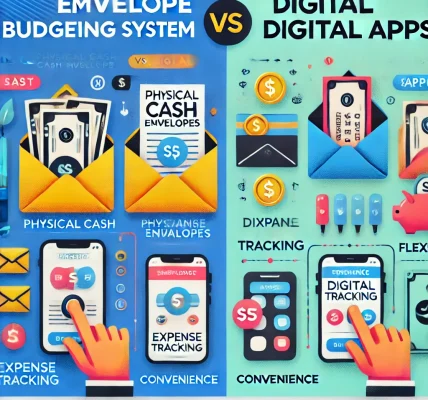In today’s fast-paced world, managing personal finances can feel overwhelming. Expenses can quickly add up, and without a structured approach, it’s easy to lose track of where your money is going. This is where zero-based budgeting (ZBB) can transform your financial life.
Zero-based budgeting is a powerful method where every dollar you earn is assigned a specific purpose. Whether you want to pay off debt, save for a major purchase, or simply gain better control over your spending, zero-based budgeting can help you achieve your goals.
In this comprehensive guide, we will explain what zero-based budgeting is, how it works, and provide a clear, actionable plan to implement it in your life.
What Is Zero-Based Budgeting?
Zero-based budgeting is a method where your income minus your expenses equals zero. Every dollar you earn is allocated to a specific category, ensuring you have full control over your financial resources. Unlike traditional budgeting, which focuses on past spending patterns, zero-based budgeting requires you to justify every expense each month.
The core principle: Income – Expenses = $0
If you earn $5,000 a month, you must allocate all $5,000 to expenses, savings, investments, or debt payments.
Why Is Zero-Based Budgeting Effective?
- Complete Financial Awareness: By tracking where every dollar goes, you gain a crystal-clear picture of your financial habits.
- Intentional Spending: Ensures that you prioritize essential expenses and financial goals.
- Debt Reduction: Allows you to allocate extra funds toward paying off high-interest debt.
- Emergency Preparedness: Helps you regularly contribute to your emergency fund.
- Adaptability: Easily adjust to changing financial situations and unexpected expenses.
Step-by-Step Guide to Implementing Zero-Based Budgeting
Step 1: Calculate Your Monthly Income
List all your income sources for the month, including:
- Salary (after taxes)
- Freelance or gig work
- Rental income
- Side hustles
- Any other consistent income
Example:
- Salary: $4,000
- Freelance Work: $500
- Rental Income: $500
Total Monthly Income: $5,000
Step 2: Identify and Categorize Your Expenses
Split your expenses into fixed and variable categories.
Fixed Expenses (Non-Negotiable):
- Rent/Mortgage
- Utilities (electricity, water, internet)
- Insurance (health, auto, life)
- Loan payments
Variable Expenses (Flexible):
- Groceries
- Dining out
- Entertainment
- Clothing
Financial Goals:
- Emergency fund contributions
- Retirement savings
- Debt payments
Step 3: Allocate Every Dollar
Match your total income to your total expenses until it equals zero.
Example Budget Allocation:
- Rent: $1,200
- Utilities: $200
- Groceries: $500
- Transportation: $300
- Insurance: $300
- Debt Repayment: $500
- Emergency Fund: $500
- Entertainment: $200
- Clothing: $100
- Savings: $1,200
Total Income: $5,000 – Total Expenses: $5,000
Step 4: Monitor and Adjust Your Budget
Track your spending throughout the month to ensure you stay within the allocated amounts. Use budgeting tools and apps to help with this process.
If you overspend in one category, adjust by reducing spending in another.
Step 5: Review and Reflect
At the end of the month, review your budget:
- Were you able to stick to the plan?
- Did unexpected expenses arise?
- Can you increase your savings or debt payments next month?
Use these insights to improve your budget for the next month.
Tips for Success with Zero-Based Budgeting
- Automate Savings: Set up automatic transfers to ensure consistent savings.
- Be Realistic: Set achievable spending limits based on your lifestyle.
- Track Every Expense: Use budgeting apps like YNAB (You Need A Budget) or Mint to monitor your progress.
- Prepare for Irregular Expenses: Allocate a buffer for annual or quarterly costs (e.g., car maintenance).
- Celebrate Small Wins: Reward yourself when you reach savings milestones.
Common Zero-Based Budgeting Mistakes to Avoid
- Forgetting Irregular Expenses: Plan for non-monthly expenses like car maintenance and holiday gifts.
- Being Too Rigid: Allow flexibility for minor changes in spending.
- Not Tracking Expenses: Without regular tracking, it’s easy to lose control.
- Skipping Budget Reviews: Monthly reviews ensure continuous improvement.
- Ignoring Small Expenses: Even minor costs add up; track everything.
Advantages and Disadvantages of Zero-Based Budgeting
Advantages:
- Complete control over every dollar.
- Helps eliminate wasteful spending.
- Prioritizes financial goals like saving and investing.
- Adaptable to changing financial situations.
Disadvantages:
- Requires time and effort to maintain.
- Can be stressful if you have unpredictable income.
- May feel restrictive for those who prefer flexible spending.
Is Zero-Based Budgeting Right for You?
Zero-based budgeting is ideal if you:
- Want to pay off debt quickly.
- Need to curb impulsive spending.
- Are working toward specific financial goals.
- Value detailed financial control and awareness.
However, if you have highly variable income, consider using a hybrid model where you combine zero-based budgeting with a rolling surplus for unpredictable months.
Conclusion: Take Control of Your Financial Future
Zero-based budgeting is a powerful tool to gain control over your finances. By giving every dollar a job, you can prioritize your financial goals, reduce debt, and prepare for the unexpected.
Start today by tracking your income, categorizing your expenses, and committing to a plan that aligns with your financial ambitions.
Disclaimer: This article is for informational purposes only and does not constitute legal or financial advice. Consult a financial advisor for personalized guidance.




